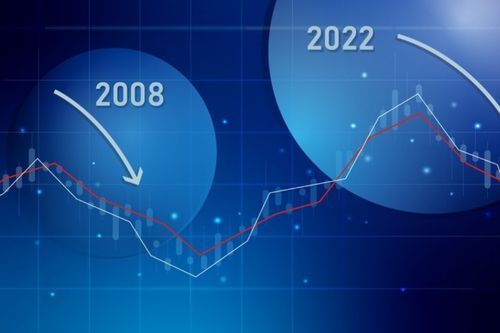
$10T Mortgage-Backed Securities Crisis Taking Shape
Before 2008, almost no one had ever heard of mortgage-backed securities (MBS). However, after 2008, almost everyone knew the term. It became common knowledge that the MBS market developed a severe liquidity crisis that took down the world economy. Surely the world learned its lesson and would never become over-leveraged in MBS again, right? Well? I don't know how to break it to you. The Bank of International Settlements (BIS) quarterly report states there is a $10T MBS liquidity crisis rapidly materializing again (pages 4-5). Never underestimate banks, governments, and individuals to relive the same mistakes.
What is Happening?
The yield spreads of MBS over U.S. Treasuries are highly volatile compared to the last 35 years of data. The red line on the graph is MBS volatility to U.S. Treasuries. More volatility presents higher default risks. Central banks and other large purchasers have left the MBS market. Small retail investors, mid-sized funds, and non-bank institutions are the source of liquidity in the MBS market. The problem is that those small investors and mid-sized institutions are the least liquid option in the $10T MBS market. The inevitable liquidity crisis will force a fire sale and a rapid price decline.


How Did We Get Here?
The pandemic created a perfect storm. Interest rates were low, and housing prices exploded. Homeowners wanted to capitalize on their newfound equity, and first-time buyers feared missing the run-up. Mortgage companies were writing many new and refinance loans. Also, the government put moratoria on evictions and guaranteed loans. The sheer volume of loans and guarantees by the government made mortgage companies look very attractive. The lockdowns and decreased labor market prompted the government to flood the system with cash. The Federal Reserve printed trillions that needed to be backed by a debt instrument, with 30% of bond purchases being MBS.
The Fed is tightening policy, raising rates, and selling the assets on its balance sheet. As interest rates rise, fewer people can afford mortgages or refinance. Refinance applications are down 86%, and new mortgages are down 40% from one year ago. Fannie Mae said October consumer confidence in the housing market was at an all-time low.
Every transaction needs a seller and a buyer. The Fed purchased trillions of MBS during the pandemic, and now, they need to sell them to get cash out of the system to slow inflation. If the Fed is the MBS seller, who is the buyer? Who wants to risk their money on MBS securities when the mortgage market is falling apart and going to get worse? Pardon me for overstating the obvious. Suppose there is no buyer, meaning the Fed can't liquidate the assets. The world is staring down another MBS liquidity crisis, like the build-up to 2008, only larger. The difference is that current policies will make Fed intervention almost impossible and the financial devastation more severe.
What Now?
The BIS hid the information about the growing MBS liquidity issues in plain sight, hoping no one would notice. The BIS allocated five small paragraphs, almost a side note, in a 90-page document. Media outlets picked up on another story in the document concerning $80T of off-the-books high-risk currency swaps posing a systemic risk but have been silent about the MBS admission.
I wrote about the $80T currency swaps and explained the situation here. It is a legitimate risk, but tools are available if defaults start happening. For example, the Fed could extend the duration of the swaps like it did in 2020. Extending the swaps doesn’t solve the problem but can kick the problem down the road for months. Short of buying more MBS, the Fed is out of tools to fix or postpone an MBS meltdown.
Here are a few quotes from the five paragraphs. Read the entire text on pages 4-5.
“There are emerging signs of fragility in the markets for agency mortgage-backed securities (MBS).”
“A shift in the composition of MBS buyers in 2022 could be a sign that the market has become more prone to bouts of volatility. Small investors and leveraged funds have become the main buyers, and they have been traditionally less forthcoming than banks in providing liquidity in times of stress. At the same time, monetary policy priorities may make it challenging for the Federal Reserve to backstop the MBS market, should the need arise. In this environment, surges in selling pressure could be particularly disruptive.”
“Liquidity disruptions in the MBS market could have material systemic implications. First of all, MBS play a crucial role in facilitating credit to the U.S. real estate sector. In addition, since MBS are near substitutes for U.S. Treasuries, liquidity strains could reverberate more broadly in financial markets.”
A friend used to say, "short term solutions often become life choices." His wisdom was that short-term thinking has long-term effects. He would make an example of a highly skilled person becoming unemployed. Depending on the situation, the person may take a position doing something unrelated to their skillset to make ends meet. Enough time would pass, and the person's resume and thinking had a brand-new trajectory. The divergence would make it harder to get hired in their field if their field rapidly changes, like technology. The short-term solution became the building block of choices going forward. The bond and MBS buying frenzy of the pandemic was a short-term solution that changed the trajectory of the U.S. economy forever and became an economic life choice. The consequences of short-term thinking forced us to face another sleeping economic dragon.
There are no guarantees, and past results don't guarantee future performance. The best we can do is look at the past to predict the future expecting a pattern to repeat. Most people reading this article lost significant wealth and retirement savings in 2008, the last time the MBS market lost significant liquidity. From 2008 to 2011, the price of gold more than doubled. If you had a second chance and knew then what you know now, how much of your retirement would you have moved into gold in 2008? How much do you want to move in 2022?
Call the U.S. Gold Bureau
(800) 775-3504









